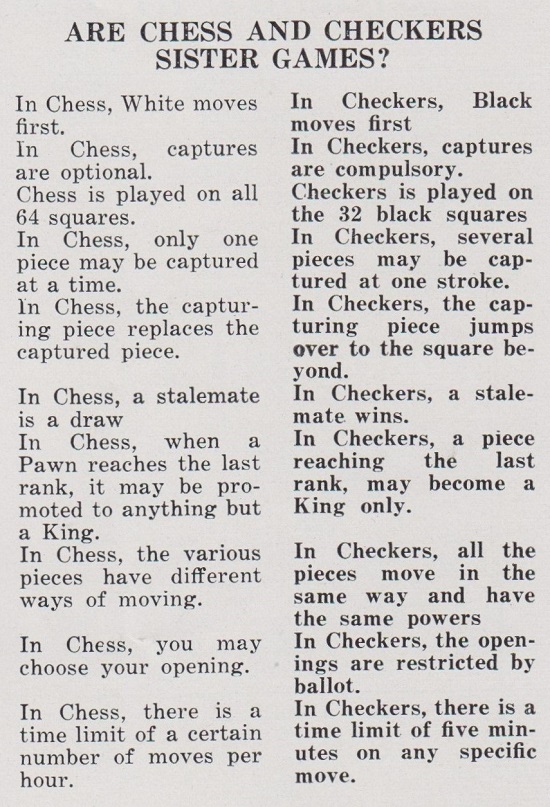
Edward Winter
From an article by Irving Chernev on page 89 of Chess Review, April 1937:

This table was also given in Chernev’s books Curious Chess Facts (New York, 1937), The Fireside Book of Chess (New York, 1949 – co-written with Fred Reinfeld), Wonders and Curiosities of Chess (New York, 1974) and The Compleat Draughts Player (Oxford, 1981).
***
In the present article, a section on individual players (N.W. Banks, Em. Lasker, H.N. Pillsbury and R.D. Yates) is followed by a series of broader C.N. items on this topic.
See our feature article on Banks.
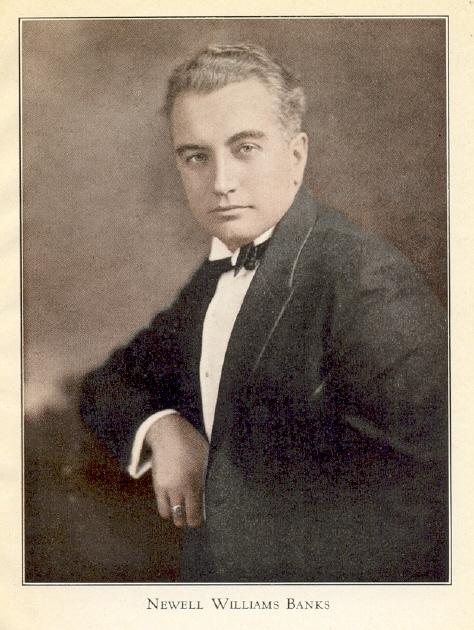
Arie van der Stoep (Hooge Zwaluwe, the Netherlands) submits a game from The Draughts Review, March 1928, page 58. It was contributed, with notes as cited below, by Black (C. Nelson of Brooklyn, who was playing Willie Ryan at the same time). The exact occasion was not specified.
1 b6-a5 c3-d4 2 h6-g5 g3-h4 3 g7-h6 h2-g3 4 d6-e5 a3-b4 (‘Here Willie Ryan played … g1-h2 with a draw.’) 5 a5-c3 d2-b4 6 e5-c3 b2-d4 7 c7-d6 b4-a5 8 d6-e5 c1-b2 9 e5-c3 b2-d4 10 f6-e5 d4-f6 11 g5-f4 g3-e5 12 e7-g5 h4-f6 13 a7-b6 a5-c7 14 b8-d2 e1-c3 15 f8-g7 f6-e7 16 d8-f6 c3-b4. Lasker won. (‘There may be a draw in this ending, but I got two pieces stuck on the side. I had to stand for a lot of nonsense from the “Boys” for losing to a chessplayer.’)
For other games of draughts/checkers by Lasker, see page 59 of Chess
Explorations (opponent: Skillcorn) and pages 97-98 of A
Chess Omnibus (opponent: Savelyev).
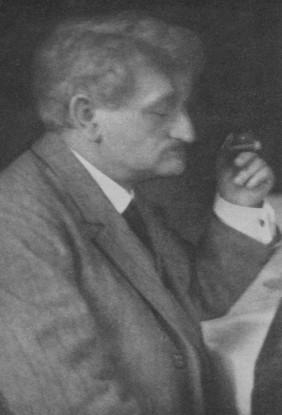
Emanuel Lasker
Alan Smith (Stockport, England) submits this game between Alfred Jordan and Emanuel Lasker from the Newcastle Morning Herald and Miners’ Advocate, 21 September 1895, page 11:
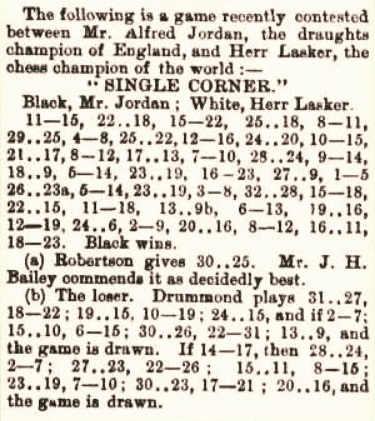
What is the original source of the Polish draughts positions involving Philidor which The Philidorian occasionally published?
(1491)
Rob Verhoeven of the chess library in The Hague writes:
‘I have asked our specialist on draughts, Mr K.W. Kruijswijk, about Philidor’s positions. They are all from Recueil de coups de dames et fins de parties difficiles, published by M(onsieur) Dufour, Paris, chez Everat, 1807:
The Philidorian: page 68, no. 6 – Dufour: no. 86
The Philidorian: page 136, no. 13 – Dufour: no. 43
The Philidorian: page 136, no. 14 – Dufour: no. 229
The Philidorian: page 137, no. 15 – Dufour: no. 274
The Philidorian: page 137, no. 16 – Dufour: no. 322.’
(1566)
Below is a game of draughts (checkers) won by H.N. Pillsbury (Black) against B.F. Scully.
1 f6-e5 e3-f4 2 e7-f6 c3-b4 3 f6-g5 d2-e3 4 g7-f6 b4-c5 5 b6-d4 e3-e7 6 g5-e3 f2-d4 7 e5-c3 b2-d4 8 f8-d6 a1-b2 9 a7-b6 b2-c3 10 h6-g5 e1-d2 11 h8-g7 d2-e3 12 g5-h4 c3-b4 13 h4-f2 d4-c5 14 b6-d4 e3-e7 15 f6-g5 g1-e3 16 d8-f6 e3-d4 17 g5-f4 c1-d2 18 g7-h6 b4-c5 19 b8-a7 a3-b4 20 h6-g5 h2-g3 21 f4-h2 d2-e3 22 h2-g1 b4-a5 23 a7-b6 c5-a7 24 c7-d6 a7-b8 25 d6-e5 d4-c5 26 g1-f2. Black wins.
The score is taken from page 176 of The Compleat Draughts Player by Irving Chernev. He stated that Pillsbury’s win was ‘one of 12 games played simultaneously blindfold, and shows his extraordinary skill at piloting the draughtsmen’, but no other details regarding the occasion were provided. What more is known about the game, and are other specimens of Pillsbury’s prowess available?
Below is the score of a game of checkers won by Pillsbury in Washington on 14 November 1903, as mentioned in C.N. 5158:
‘And this is what Mr Pillsbury did to Paul F. Grove. Pillsbury’s move.’ f6-e5 c3-d4; e5-c3 b2-d4; h6-g5 a1-b2; d6-c5 g3-f4; g5-h4 d2-c3; g7-h6 d4-e5; e7-d6 e3-d4; c5-e3 f2-d4; h8-g7 e1-f2; f8-e7 f2-e3; e7-f6 g1-f2; d8-e7 c3-b4; h6-g5 f4-f8. ‘All over.’
Source: Washington Times, 21 November 1903, page 8.
For readers’ convenience we have converted the score from ‘11-15 22-18’, etc. to the algebraic notation.
See too C.N.s 7122, 7126 and 11046 concerning variants of the remark ‘Chess is what you see; checkers is what you know’.
Pillsbury’s chess and checkers column on page 2 of the Philadelphia Inquirer, 5 March 1905 was shown in C.N. 9597:
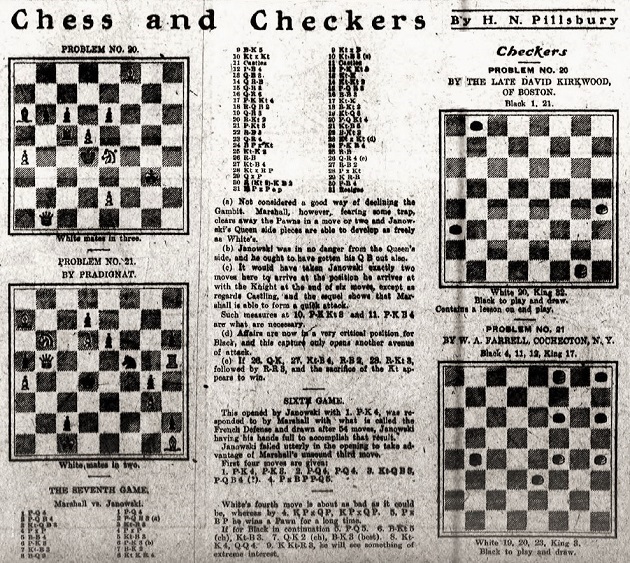
Gerard Killoran (Ilkley, England) draws attention to page 3 of Part II of the Minneapolis Journal, 12 January 1901, which, in addition to information on Pillsbury and chess, has some games of checkers played by Pillsbury.
From page 14 of R.D. Yates Checker Player by W.T. Call (New York, 1905):
‘Paul Morphy, the chess genius, sought to obtain a glimpse into the scientific depths of checkers without too much trouble, but never succeeded in getting within sight of anything under the surface of the game. When he went to England he asked Thomas Lear, who played both checkers and chess, to explain to him “wherein the beauty of draughts playing lay”. On another occasion, half in jest, half in earnest, the great chess master said to a New York player, “Checkers is for tramps”.
W.J.A. Fuller, chess editor of Leslie’s Illustrated Newspaper, declared that checkers is “all bosh”, although he was what the checker editor of the New York Clipper called “a bold, dashing and original draughts player”. Hodges, the Buffalo expert, was beating Fuller at checkers repeatedly, to the great satisfaction of the bystanders, when the author of the “all bosh” remark claimed he had an easy draw, and his offer to make a bet and give odds on it was quickly taken. Fuller won the bet by gently drawing his knees apart and allowing the board and men to fall to the floor. This, by the way, is the origin of “Fuller’s draw”, a phrase sometimes used to describe the only thing an inferior player might expect to get from an adept.’
Wanted: substantiation of the foregoing, and particularly the material about Morphy.

An assessment of Robert D. Yates, including references to chess, on pages 55-56 of R.D. Yates Checker Player:
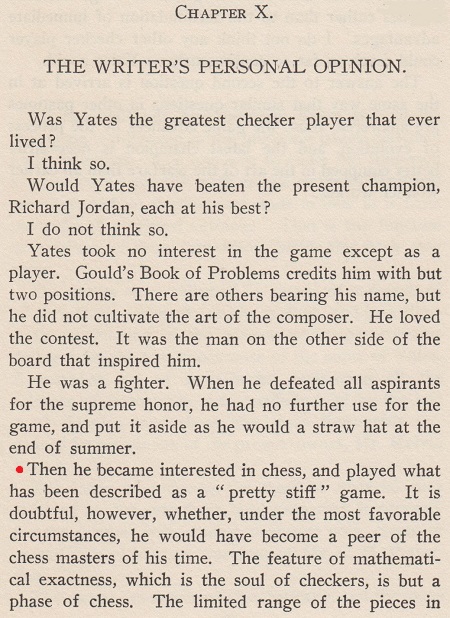
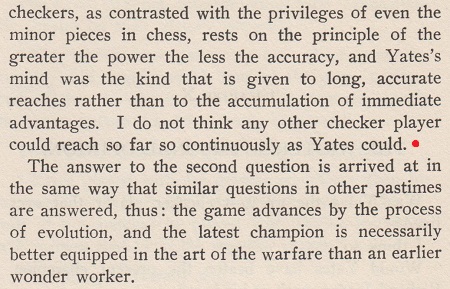
Page 3 of the Brooklyn Chess Chronicle, 15 October 1883 reported on a meeting of the Danites Chess Club of Brooklyn on 27 September:
‘Mr Robert Yates, the well-known champion checker player, was present and showed that he could also play chess.’
See too page 34 of the February 1907 American Chess Bulletin, which had comments on Yates by George S. O’Flyn, the originator of Spy-Chess.
This photograph is reproduced with the permission of the Cleveland Public Library:
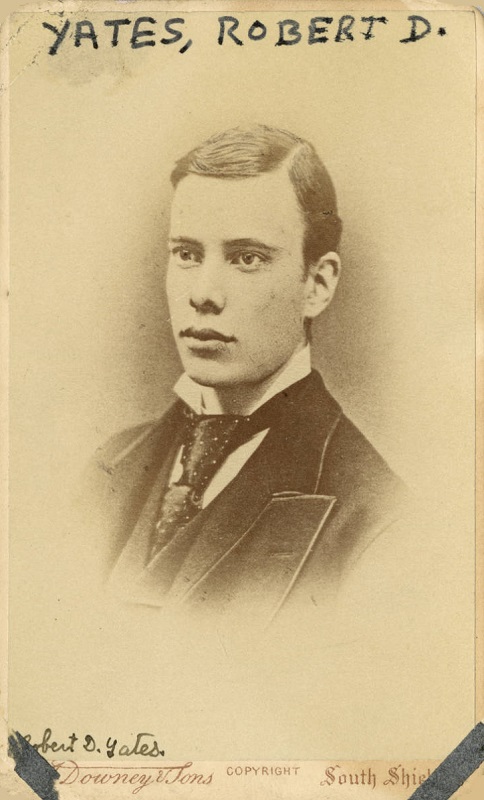
There are webpages which state that Yates died, at the age of 27, on 19 September 1885. As shown below, his death had already been announced earlier that month:
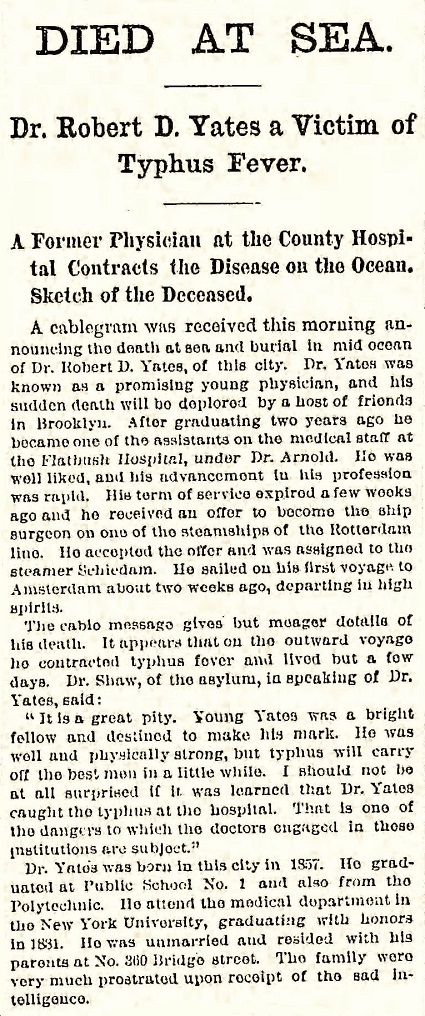
Brooklyn Daily Eagle, 2 September 1885, page 4
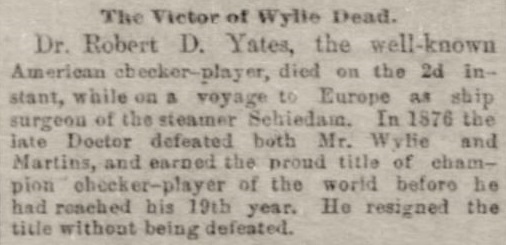
Pittsburgh Commercial Gazette, 12 September 1885, page 5
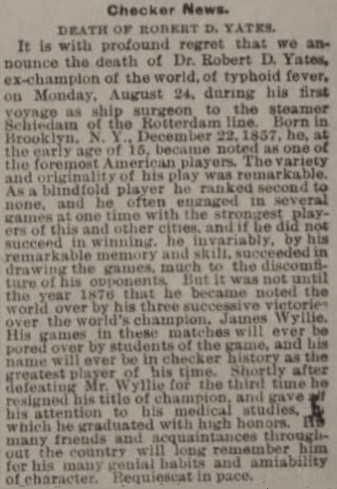
Boston Weekly Globe, 22 September 1885, page 3.
The contradictory death-dates will be noted.
Biographical information on Yates and a number of his games can be found in The Compleat Draughts Player by Irving Chernev.
Arie van der Stoep sends some references to chess masters (Marshall, Lasker and Banks) in draughts literature:
The Draughts World, July 1910, page 3:
‘Mr F.J. Marshall, the great American chessist, like Pillsbury, is also an expert draughts-player. At the rooms of the YMCA, New York City, he recently played 15 games simultaneously at chess and 15 at draughts. He won 14 games at chess, losing one; and 13 at draughts, losing one and drawing one.’
The Draughts World, July 1911 (cover):
‘Some years ago, Mr Lasker, the world’s champion at chess, made himself fairly acquainted with some of the leading lines of play in checkers, as given by the old authors, and while located at Chicago giving chess exhibitions, with an occasional game of checkers, he played the game up to this stage (L0 20-16) and remarked: “Now, the books play 9-14 here, instead, I go 3-7, 23-18, 7-11, 16-7, 1-12 and win for Black with a piece down.” The remark was addressed to a very prominent Chicago checker-player, who immediately responded with 17-14, 10-26, 31-22, winning for White, and incidentally demonstrating the subtlety of checkers.’
The Draughts Review, December 1927, page 231:
‘Mr Banks was playing ten games blindfolded. Among the players were Alfred Jordan (he was always glad to play) and Dr Lasker, the chess champion.’
Charles Tomlinson’s comments in C.N. 3464 came from an article entitled ‘Buckle as a Chessplayer’ on pages 328-336 of the July 1891 BCM. A more detailed treatment of the same subject is to be found in Buckle: ritratto inedito di un dilettante by V. Laudi (Brescia, 1994), but what is known of Buckle’s skill, or otherwise, at draughts (checkers)?
Page 14 of volume one of The Life and Writings of Henry Thomas Buckle by A.H. Huth (London, 1880) has a diagram with the following narrative:
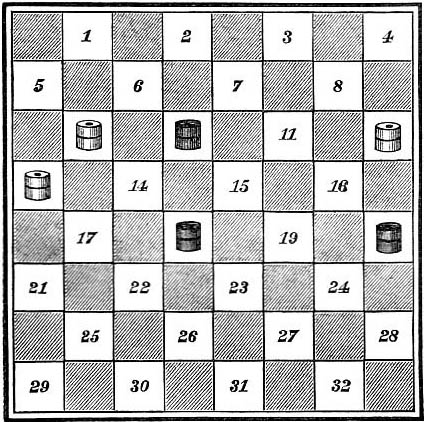
White wins
‘Buckle was proud of his skill in all games not dependent on manual dexterity. It was in Paris that, while watching a game of draughts outside a café, he told the players who had just drawn it that it might be won by White in three moves. They, who knew nothing of him, would not believe him; upon which Buckle made a bet, and won it. The exact position I do not know, but it was something of the same kind as given in the annexed woodcut.’
A footnote gave the solution as ‘White 12 to 16; Black 20 to 11; White 9 to 14; Black 10 to 17, or 18 to 9; when White wins’.
(3465)
A rare chess term is une lunette, in the context of a pawn fork. To the extent that it was ever commonly used in France or elsewhere, when did it fall out of favour? Below is the definition given on page 140 of Traité d’échecs analytique et progressif by A. Lonchay (Brussels, 1917):
‘Donner une lunette à son adversaire, c’est le mettre en état d’attaquer deux pièces en même temps avec un pion, ce qui arrive quand les deux pièces occupent une case en avant de celle du pion et la touchant diagonalement; on reçoit une lunette, dès que cette éventualité se produit.’
Jean-Pierre Rhéaume (Montreal, Canada) notes that the Dictionnaire Littré provides definitions for lunette concerning both draughts and chess:
‘Au jeu de dame, mettre dans la lunette, placer une dame entre deux dames de son adversaire, en sorte qu’elle ne peut être prise ni par l’une ni par l’autre; locution tirée de la forme des lunettes qu’on met sur le nez.
Au jeu des échecs, donner une lunette, mettre son adversaire à même d’attaquer deux pièces avec un pion.’
From page 74 of The Fireside Book of Chess by I. Chernev and F. Reinfeld (New York, 1949):
‘In 1851 the Chess Champion of the world was A. Anderssen; the Checker Champion of the world was A. Anderson.’
This is quoted not to prompt a discussion about Anderssen’s chess status in 1851 but to ask whether Anderson was indeed recognized at that time as world champion at draughts/checkers. In C.N. 3030 (see page 269 of Chess Facts and Fables) a correspondent enquired whether chess was the first field to use the title ‘world champion’, a question which remains open.
Ralph Blewitt (Antwerp, Belgium) draws attention to a webpage providing information about Andrew Anderson and stating that ‘he was the first World Champion the game of draughts produced, a title which was really his from about 1830 until 1848 when he retired undefeated’. Moreover, Robert John McCrary (Columbia, SC, USA) points out a webpage with details about the career of James Wyllie.
Which early primary sources used the term ‘world champion’ with regard to either Anderson or Wyllie?
A further contribution from our correspondent in Belgium is the title page of an 1881 book by Wyllie, in which he is described as ‘champion draughtplayer of the world’:
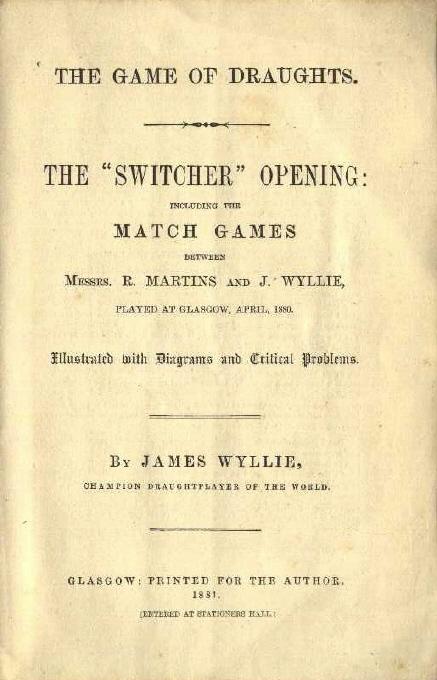
Alan McGowan (Waterloo, Canada) points out that Irving Chernev also mentioned Anderson on page 6 of his book The Compleat Draughts Player:
‘Andrew Anderson was the first man to be recognized as World Champion, by virtue of his victory over James Wyllie in 1847 in a match for the title. He scored nine wins to six losses, with 31 games drawn.
On his retirement, the title passed to Wyllie, who held it on and off for 40-odd years.’
Arie van der Stoep is the author of two books in English which may be of particular interest to students of the early history, or pre-history, of both chess and draughts. A History of Draughts (Rockanje, 1984) has the explanatory subtitle ‘with a diachronic study of words for draughts, chess, backgammon and morris’. A summary of Draughts in Relation to Chess and Alquerque (Hooge Zwaluwe, 2007) is provided on the book’s back cover:
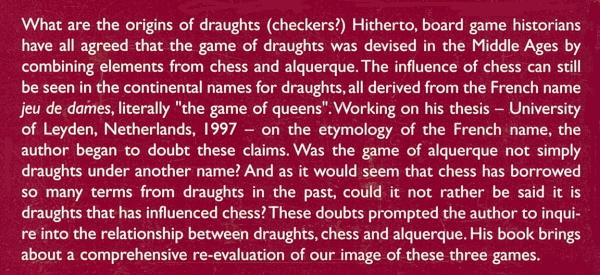
Mr van der Stoep’s research is both historical and etymological, and he concludes that until circa 1800 draughts, not chess, was the major board game.
Over de herkomst van het woord damspel (Rockanje, 1997) is a further work by him (in Dutch, with English and French summaries) which argues, on the basic of linguistic evidence, that draughts (the jeu de dames) is not necessarily a ‘daughter’ of chess.
All three volumes can be ordered from Mr van der Stoep’s website A history of checkers/draughts. [Note on 19 October 2018: this link no longer works.]
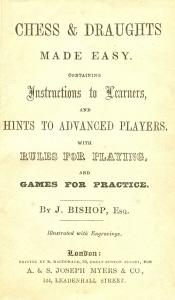
Some more information can, at last, be provided on Chess & Draughts Made Easy by J. Bishop, a book from the mid-nineteenth century which we possess but have never seen mentioned in any chess catalogue or bibliography (see page 366 of A Chess Omnibus and page 269 of Chess Facts and Fables).
Michael Clapham (Ipswich, England) reports that he has recently inspected a copy of the Bishop work at the British Library in London:
‘The book is undated, but the British Library dates it as circa 1855. It is a delightful little work bound in blue cloth-covered boards, blind-stamped and with the title on the front cover in gilt. All edges are gilt and the book has lemon glazed endpapers.
I also examined Draughts and Chess for the Millions! – The whole art of chess and draughts published by J. Cleave (London, 1844?), which has chess on pages 3-21 and draughts on pages 21-23. Large parts of the Bishop book up to page 16 are very similar to Draughts and Chess for the Millions. The “Advice to Beginners” from page 16 onwards is largely taken from Hoyle’s Rules for Chess (included in many editions of Hoyle’s Games), which are also in Draughts and Chess for the Millions. There the chess section of the “Millions” book ends, whereas the Bishop work continues with a selection of openings and games.
It is, indeed, curious that Bishop’s book is apparently not mentioned in any chess bibliography or catalogue. I have also ascertained that the book is not recorded in the standard draughts bibliography, The Literature of Checkers by William T. Call (New York, 1908).’
Although it is nearly five years since we raised the subject of the Bishop book (in C.N. 2710), this is the first time that the existence of another copy has been notified to us. A curiosity is that whereas the cover of the edition inspected by Mr Clapham is blue, ours is red.
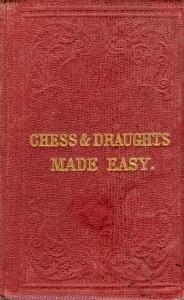
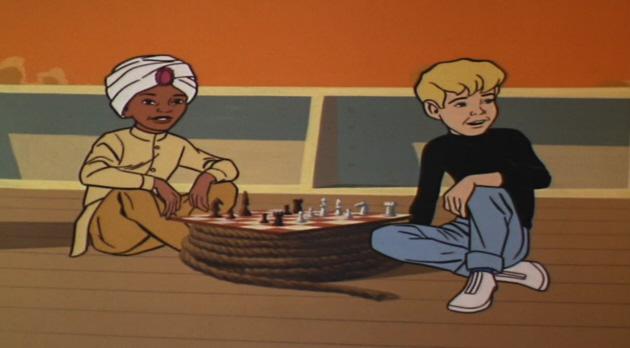
Few animated series have featured chess, but the above shot, showing Hadji and Jonny Quest, comes from ‘Dragons of Ashida’, an episode in the US production Jonny Quest (first broadcast in 1964-65).
At the start of another episode, ‘Attack of the Tree People’, Dr Benton Quest was playing chess with Race Bannon, while Jonny Quest and Hadji played checkers.
(6746)
What on earth has happened to the standards of accuracy and integrity usually applied by ChessBase.com in the past?
There is, for instance, an individual named Albert Silver who cobbles together articles by indiscriminately hoovering up images instantly available via an Internet search.
As regards the indiscriminate nature of his ‘work’, below is what appeared in (but has since been removed from) an article of his about chess and film stars which ChessBase.com posted on 23 February 2015:
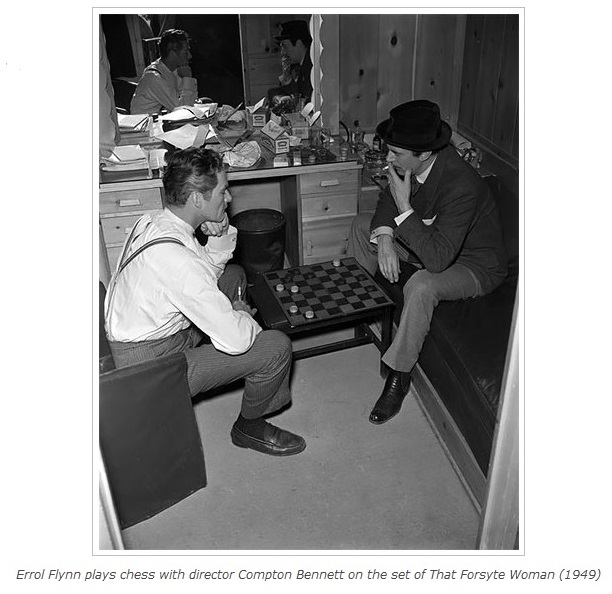
Below is correspondence published in The Listener (6 November 1958, page 741 and 13 November 1958, page 786). It discusses draughts/checkers and Edgar Allan Poe, in response to an article on pages 610-611 of the 16 October 1958 issue by C.H.O’D. Alexander:
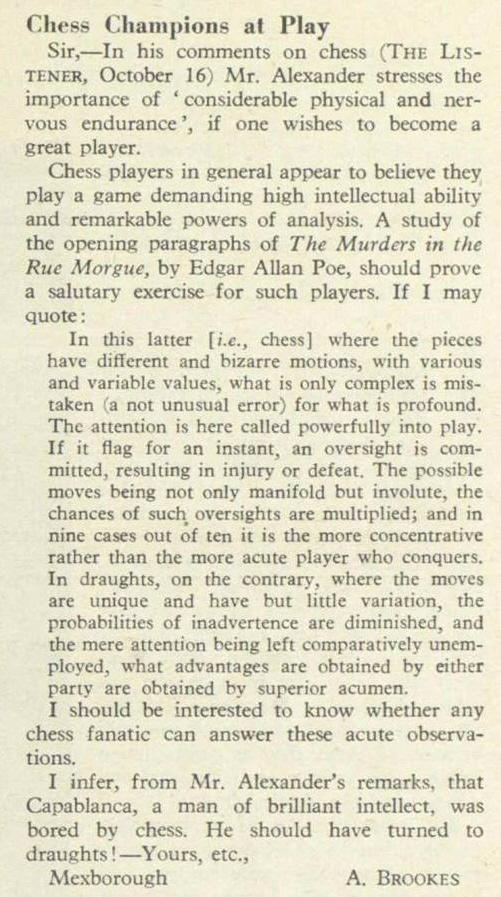
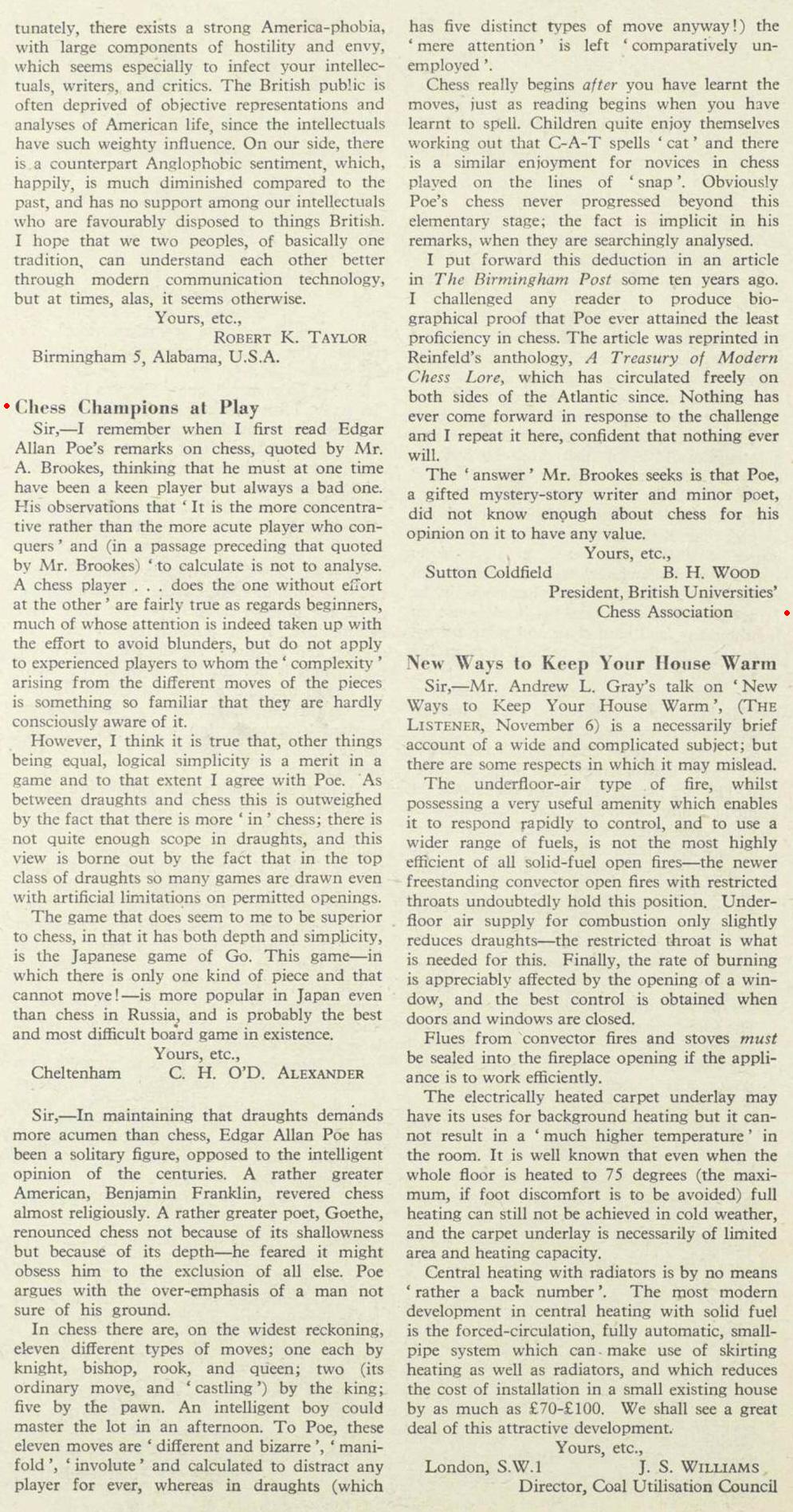
(8138)
Dan Scoones (Port Coquitlam, BC, Canada) points out an exterior shot of the New Orleans Chess, Checkers and Whist Club, taken in 1903, and a brief history of the Club.
The benefits of playing chess are often extolled, but similar arguments are found for draughts/checkers. A random example, written by Morris Steinberg, is on page 3 of Morris-Systems Scientific Checkers edited by Newell Williams Banks (Detroit, 1923):
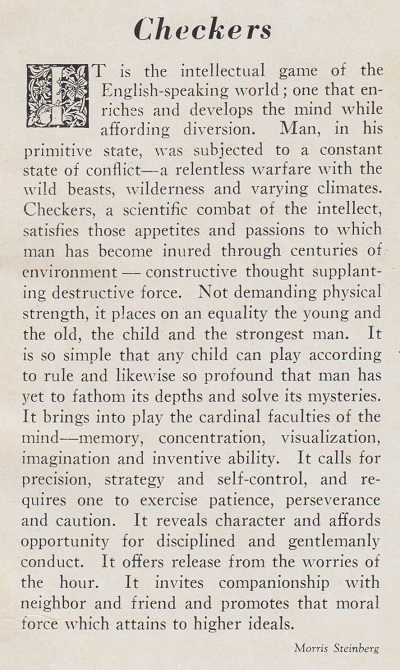
Concerning David A. Mitchell’s writing on chess and checkers, see Disappeared.
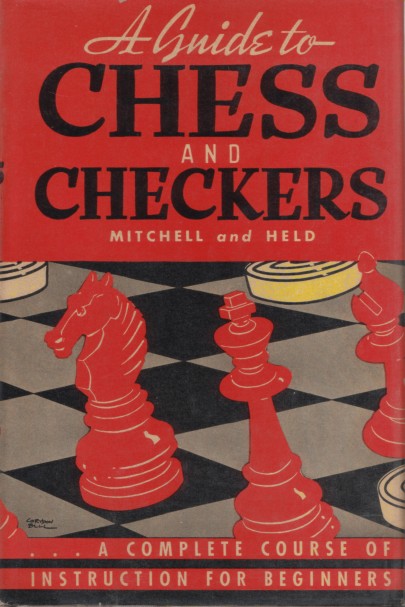
Another book which has been referred to in C.N. items is Chess and Checkers The Way to Mastership by Edward Lasker (New York, 1918).
Regarding Kenneth Grover, see our article on hype.
From Arie van der Stoep:
‘As shown on my website, I have carried out a comparative investigation into the social position of chess, draughts and other board games. Chess historians have, unfortunately, neglected it, but how can one establish the popularity of a game without comparative research?’
(11133)
Details are requested regarding this paragraph on page 48 of the American Chess Bulletin, February 1927:

Noting that the Draughts World ceased publication in 1913, the Cleveland Public Library has looked for the article in a 1926 or 1927 issue of the Draughts Review, but without success.
(11322)
Some more games of draughts/checkers played by Emanuel Lasker, against Charles Welen and Charles Hefter, have been forwarded by Richard Forster (Zurich).
From the Inter Ocean (Chicago), 14 December 1902, page 58:
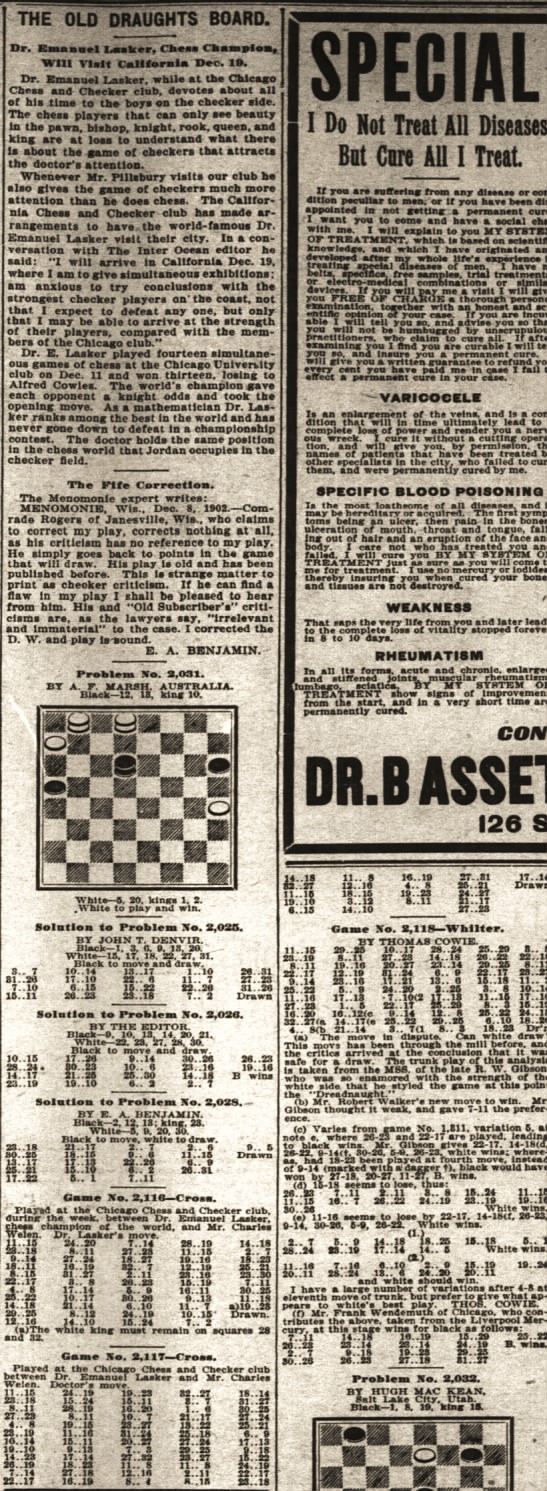
From page 15 of the 1 February 1903 edition of the same newspaper:

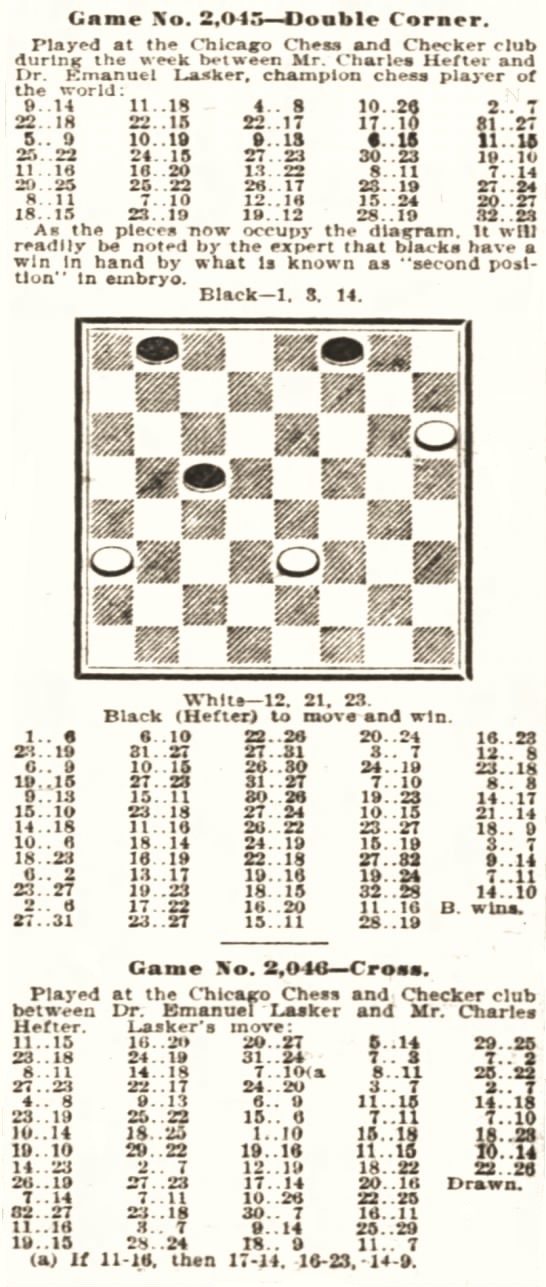
(11314)
Yuri Kireev and Mikhail Sokolov (Moscow) have submitted two games. The first, from pages 127-128 of the 4/1897 Shakhmatny Zhurnal, was played in Moscow on 21 November 1896 (old style). Lasker’s opponent was P. Bobrov, and the notes were by V.I. Shoshin:
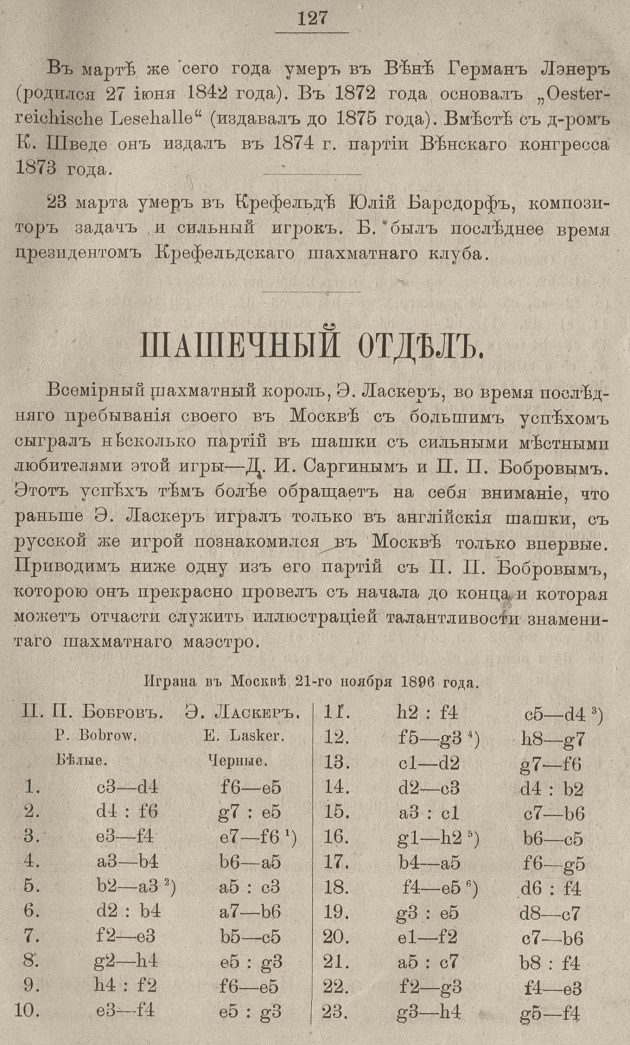
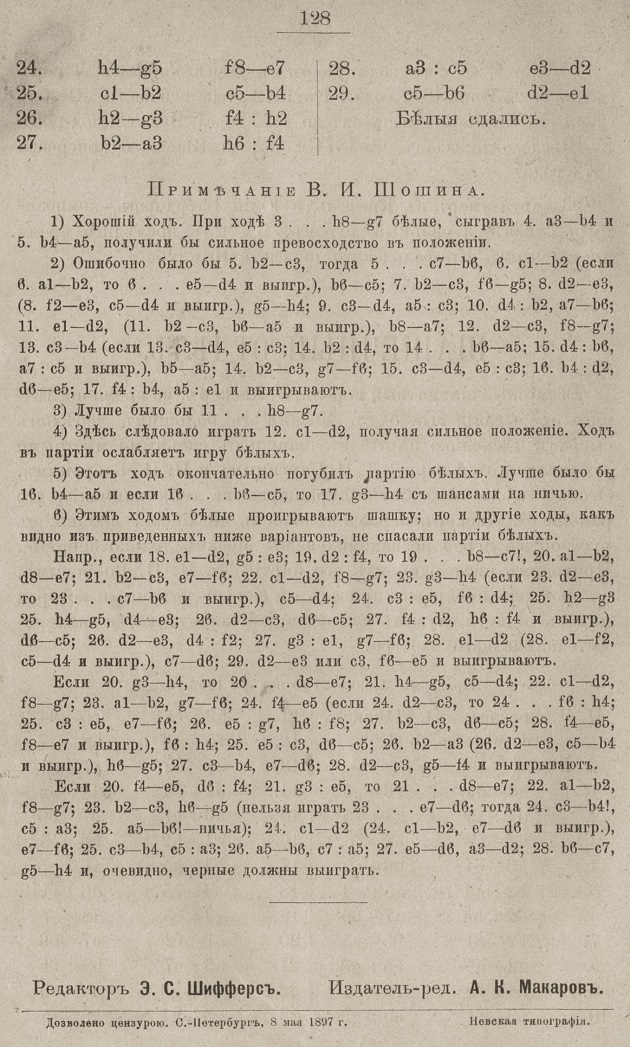
In the second game, from pages 194-195 of the 5-6/1897 Shakhmatny Zhurnal, Lasker faced Shoshin, who again supplied the notes. The game was played in St Petersburg on 17 January 1897 (old style):
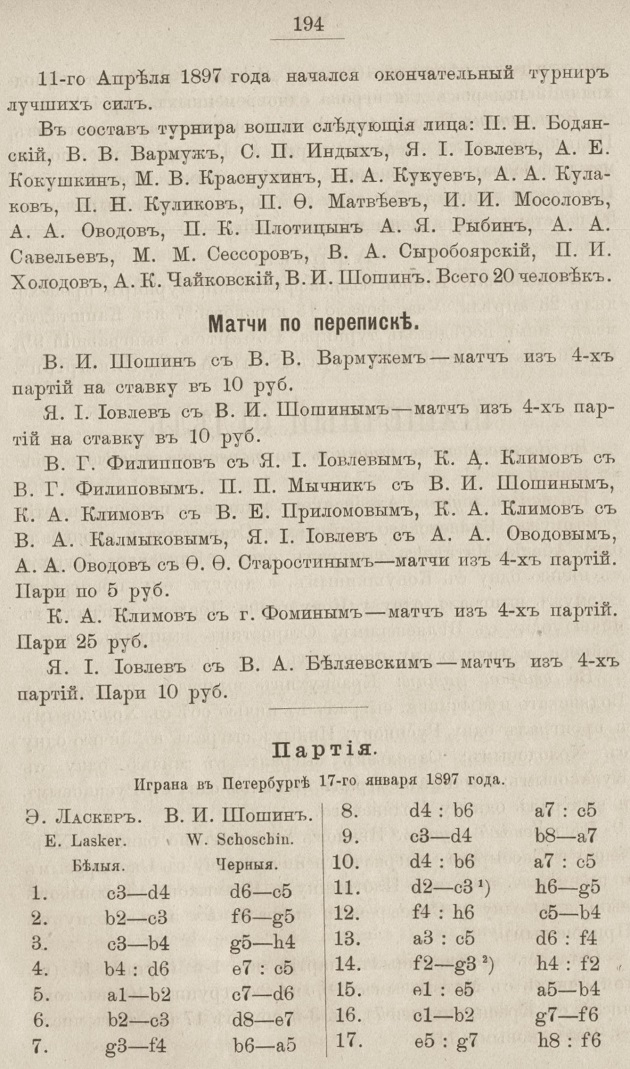
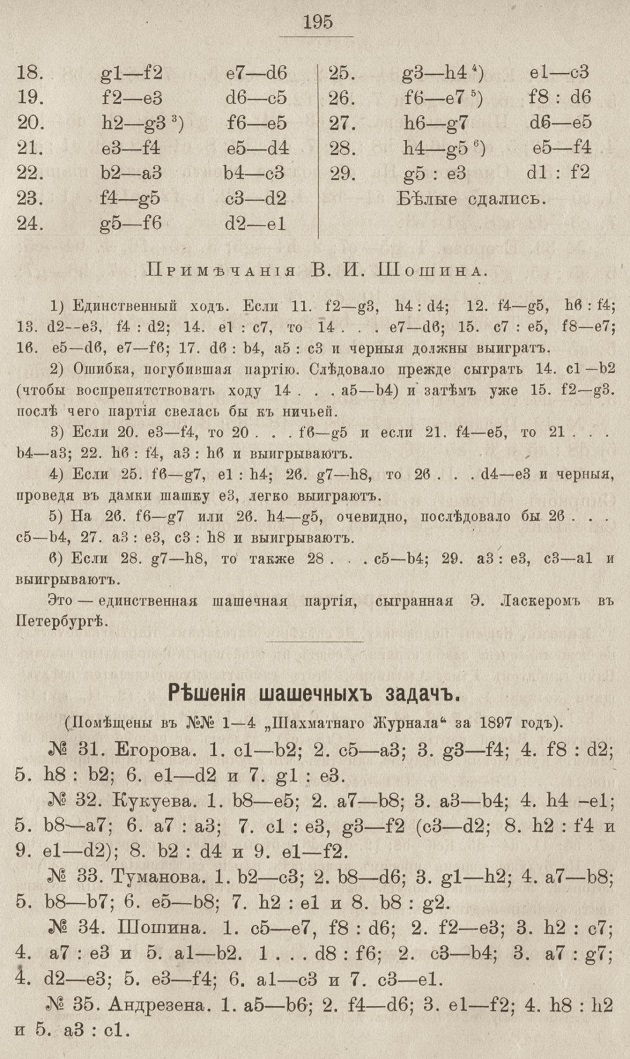
(11363)
Richard Forster writes:
‘On page 78 of The Collected Games of Emanuel Lasker (Nottingham, 1998) K. Whyld mixed up the colours when he gave the above Lasker v Shoshin game. The final moves were published in Niva, literary supplement, January 1900, columns 221-222 as 30 a3-b4 c3xh8 31 b4xd6 h8-e5 32 d6xf4 f2-g1 33 f4-e5 g1-c5.’
Addition on 24 January 2020:
With the assistance of Yuri Kireev and Mikhail Sokolov, Richard Forster provides four further games played by Emanuel Lasker:
1) V.I. Shoshin v Lasker, St Petersburg, 1895/96. Source: Rasskazy o shashkakh i shashistakh by A.V. Rokitnitsky (Minsk, 1972), pages 25-26:
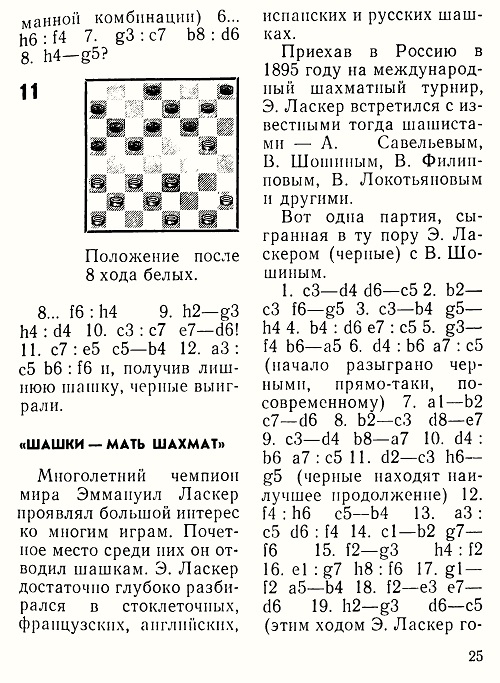
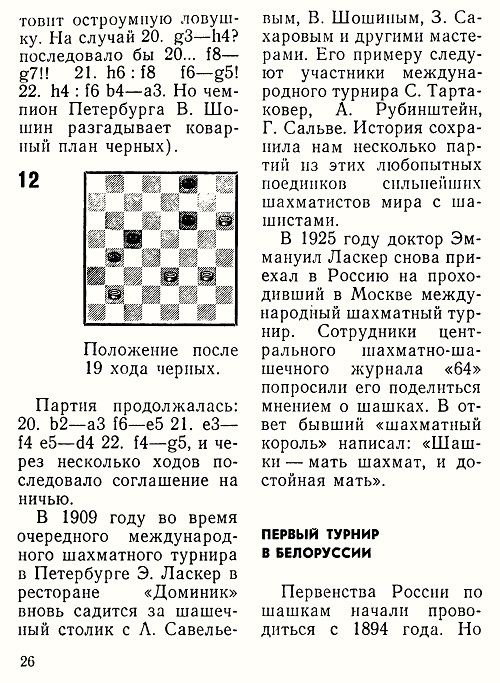
2) Lasker v P.P. Bobrov, Moscow, 1896/97. Source: Odesskie Novosti, 18 June 1900, page 4:
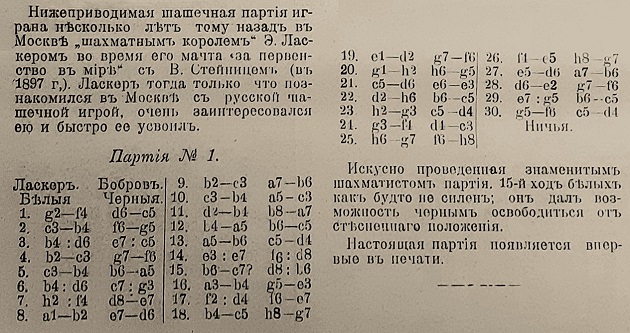
3) Lasker v Z.I. Sakharov, St Petersburg, 14 February 1909. Source: Listok Shashista, February 1909, pages 21-24.
4) Lasker v L. Glezer, Moscow, 1936. Source: Shashki, January-February 1967, pages 18-19:
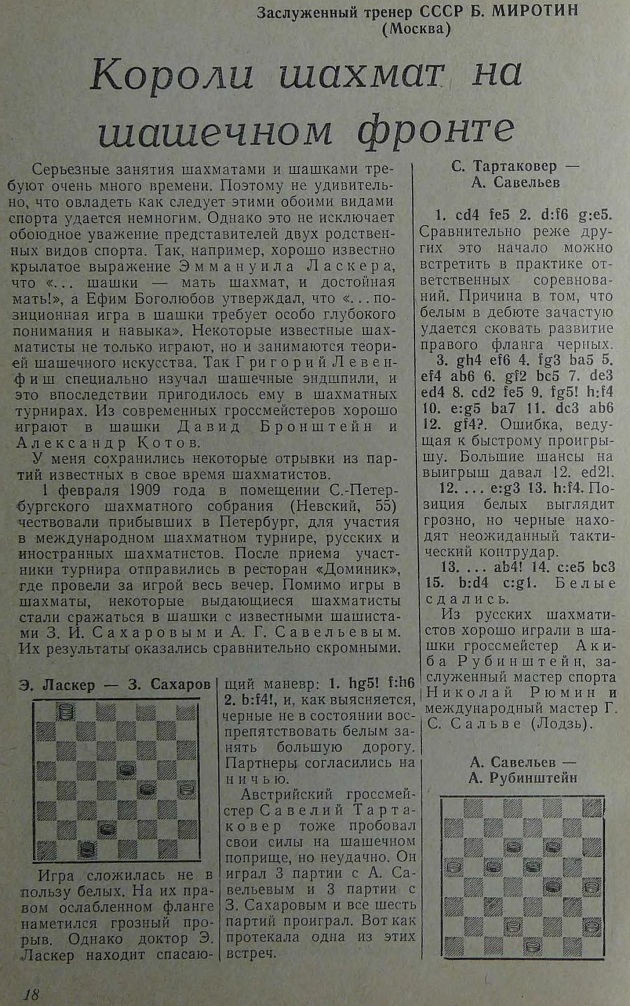

See also A list of magazines and papers having checker or chess columns (Cleveland Public Library).
Addition on 20 March 2024:
‘Christmas [1914] was spent in a state of simmering discontent among his landlocked stokers, who do not seem to have entirely taken on board the correct war spirit. Brooke tried to alleviate their boredom with games like draughts and hoops, supplied by his well-meaning Uncle Alan, the Dean of King’s.’
Source: Rupert Brooke. Life, Death & Myth by Nigel Jones (London, 1999), page 398.
See also Rupert Brooke and Chess.
The first paragraph of a review of The American Draught-Player by Henry Spayth (New York, 1860) on page 505-506 of the Atlantic Monthly, April 1860:
‘Almost everybody plays the game of draughts, but few have any insight into its beauties; and many who look upon chess as a science rather than an amusement regard draughts as a childish game, never suspecting what eminent ability and painstaking research have been expended in explaining a game which is inferior to chess only in variety and far superior in scientific precision.’
(12078)
Addition on 15/17 January 2025:
Richard Pask (Weymouth, England) informs us that he has three books (Checkers for the Novice, Complete Checkers: Insights and Complete Checkers: Repertoire which are available on Amazon and can also be downloaded without cost from The Checker Maven.
Our correspondent adds:
‘The tactical aspects of the game are well known (Chernev considered it to be 99% tactical), but the strategic hardly at all. These are brought to the fore in Complete Checkers: Insights, as a quick review of the contents page will reveal.
Diagram 377 of Complete Checkers: Insights features the conclusion of an “odds” game (12 men v 11) between Larry Evans and Tom Wiswell, where the latter secures a neat draw.’
To the Archives for other feature articles.
Copyright: Edward Winter. All rights reserved.